by Susan Flantzer
© Unofficial Royalty 2022

The Friedenskirche with the domed Kaiser Friedrich Mauseleum on the left; Credit – By Arild Vågen – Own work, CC BY-SA 3.0, https://commons.wikimedia.org/w/index.php?curid=29982486
The Friedenskirche (Church of Peace) is a Lutheran church in Sanssouci Park, surrounding Sanssouci Palace, in Potsdam, Germany. Sanssouci Palace was built between 1745 – 1747 in Potsdam, Kingdom of Prussia, now in the German state of Brandenburg, during the reign of Friedrich II (the Great), King of Prussia as his summer palace.
Sanssouci Park contains other structures including:
- Chinese House: a garden pavilion built during the reign of Friederich II
- New Chambers: built during the reign of Friederich II, contains guest rooms and two ballrooms
- New Palace (Neues Palais): with over 200 rooms, built during the reign of Friederich II (the Great), King of Prussia, at the end of the Seven Years’ War, to celebrate Prussia’s success
- Picture Gallery: built during the reign of Friederich II to exhibit his art collection
- Temple of Antiquities: originally built to display Friedrich II’s antique collection, it is now the burial site of several members of the House of Hohenzollern (see below)
- Temple of Friendship: built by Friedrich II in memory of his sister Princess Wilhelmine of Prussia
********************
History of the Friedenskirche
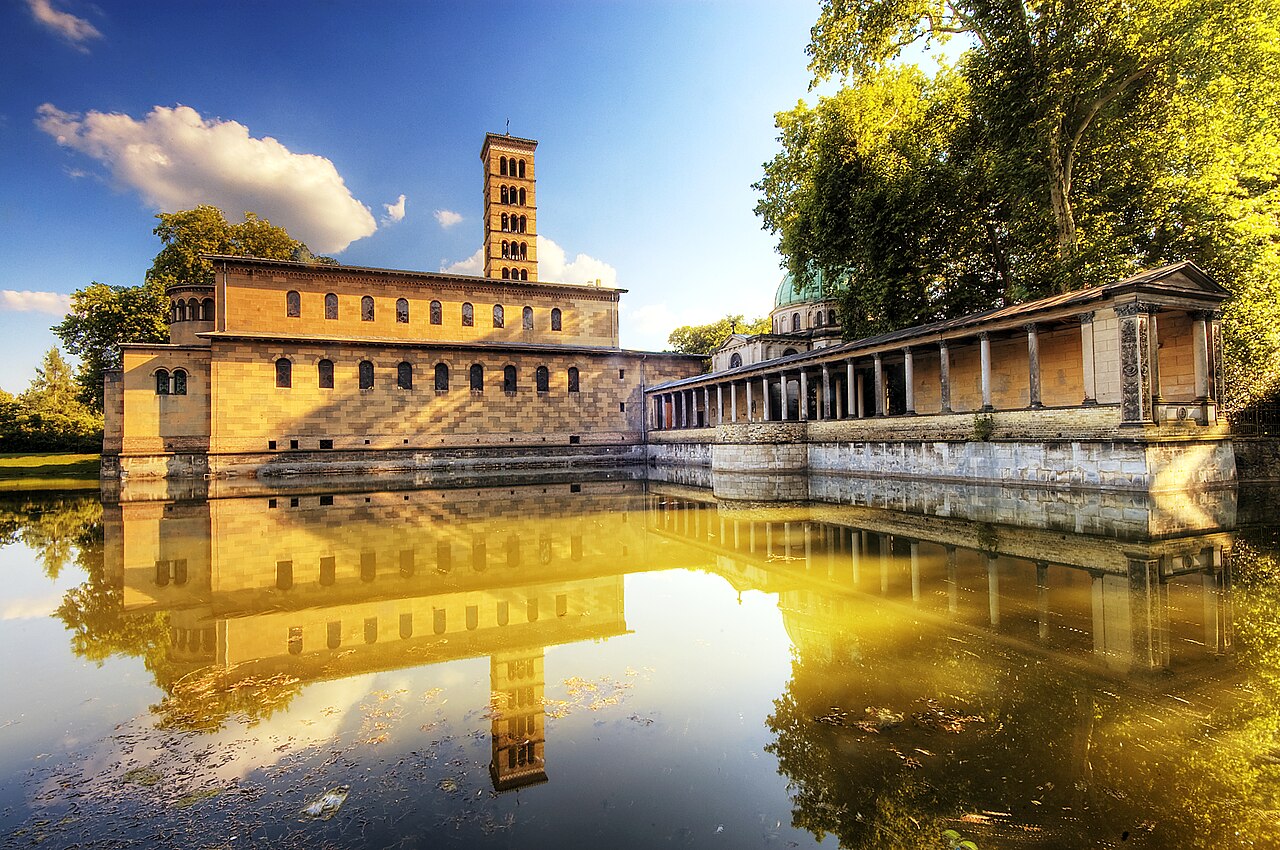
The Friedenskirche with the domed Kaiser Friedrich Mausoleum of the right; Credit – By Wolfgang Staudt – originally posted to Flickr as Potsdam Friedenskirche, CC BY 2.0, https://commons.wikimedia.org/w/index.php?curid=3988614
In 1839, as Crown Prince of Prussia, Friedrich Wilhelm IV, King of Prussia devised a preliminary plan for a church in the Sanssouci Park that would meet the needs of the Prussian court to worship while in summer residence at Sanssouci Palace. He envisioned a church with a lake, a park, and additional buildings. When Friedrich Wilhelm IV became King of Prussia in 1840, he began to carry out those plans. However, he was quite particular and repeatedly rejected the designs of the court architect Friedrich Ludwig Persius. After nearly two years, Friedrich Wilhelm III approved Persius’ plans. The cornerstone was laid on April 14, 1845. However, three months later Persius died and architect Friedrich August Stüler continued the project. On September 24, 1848, the Friedenskirche was consecrated in the presence of King Friedrich IV and his wife Elisabeth Ludovika of Bavaria, Queen of Prussia. The church served not only as a chapel royal but also as a church for the parish of Brandenburger Vorstadt, a part of Potsdam.
********************
The Exterior of the Friedenskirche

Friedenskirche; Credit – Von Gemeingut im Foto – Eigenes Werk, Gemeinfrei, https://commons.wikimedia.org/w/index.php?curid=39348752
The Friedenskirche was built in the style of an early Christian church with buildings surrounding the church built in the style of northern Italian monastery buildings.
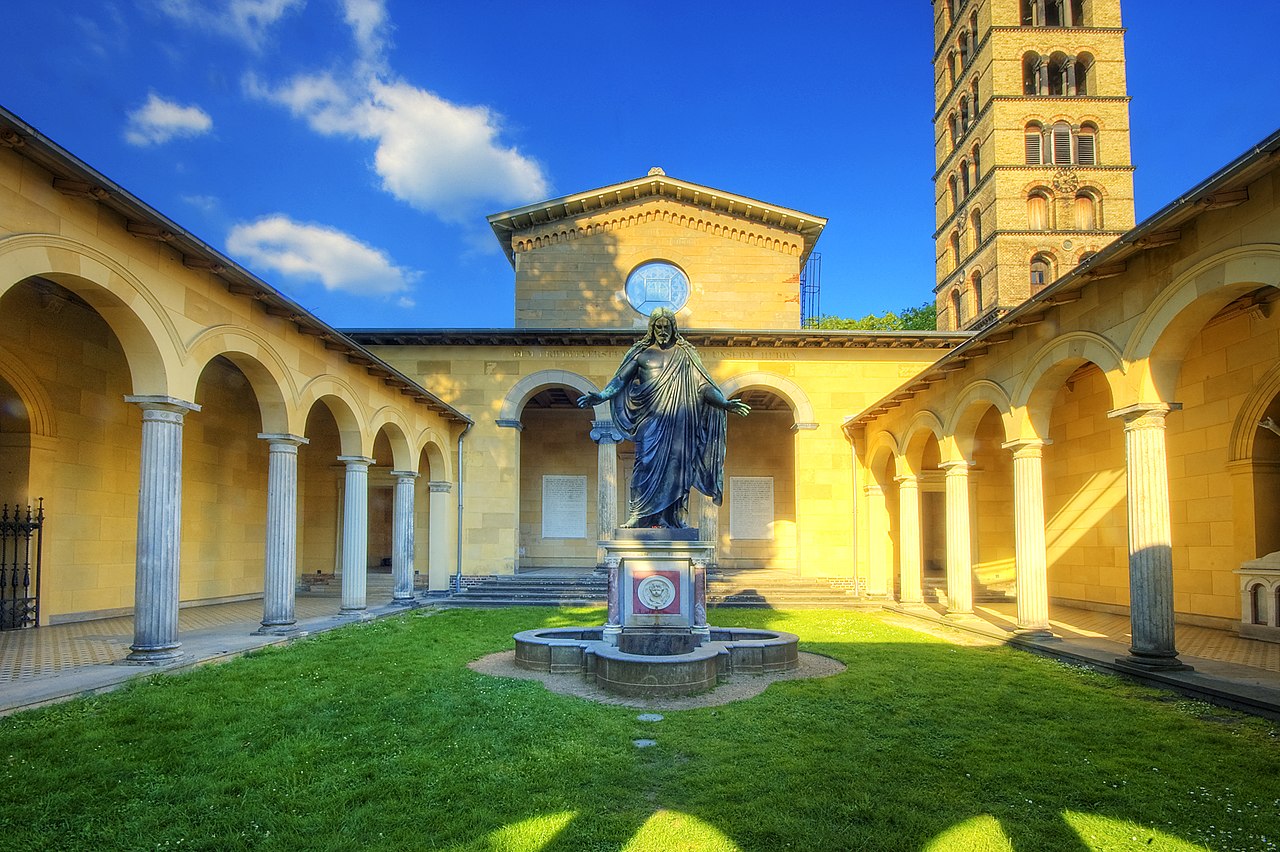
The inner courtyard with the statue of Christ: Credit – By Wolfgang Staudt – originally posted to Flickr as Church of Peace, CC BY 2.0, https://commons.wikimedia.org/w/index.php?curid=3988611
There is an inner courtyard with a fountain and a life-size statue of Christ, a copy of the 1821 statue by Danish sculptor Bertel Thorvaldsen in the Church of Our Lady in Copenhagen, Denmark.

The bell tower; Credit – Von Miguel Hermoso Cuesta – Eigenes Werk, CC BY-SA 4.0, https://commons.wikimedia.org/w/index.php?curid=37843644
Next to the church is a free-standing bell tower modeled after the bell tower at the Basilica of Santa Maria in Cosmedin in Rome, Italy.

Steinbrück fresco depicting Jesus praying in the Garden of Gethsemane; Credit – By Elena Jamov – Own work, CC BY-SA 3.0, https://commons.wikimedia.org/w/index.php?curid=21668281
On the eastern side of the church, there is a fresco by German painter and etcher Eduard Steinbrück depicting Jesus praying in the Garden of Gethsemane.
********************
The Interior of the Friedenskirche

The interior of the Friedenskirche; Credit – By Jochen Teufel – Own work, CC BY-SA 3.0, https://commons.wikimedia.org/w/index.php?curid=7216909
The Friedenskirche is a columned basilica with three aisles and no transept.

The 13th century mosaic in the aspe; Credit – Von Karl-Heinz Meurer (–Charlie1965nrw) – HDR-Bild aus drei digitalen Fotografien, selbst fotografiert, CC BY-SA 3.0, https://commons.wikimedia.org/w/index.php?curid=11906128
When he was Crown Prince of Prussia, Friedrich Wilhelm IV had purchased at auction a 13th-century mosaic from a church that was going to be demolished, the 1109 Church of San Cipriano on Murano near Venice, Italy. The Byzantine mosaic shows Jesus Christ seated on a throne as the judge of the world. This mosaic was installed in the apse over the altar.

The main altar; Credit – By J.hagelüken – Own work, CC BY-SA 3.0, https://commons.wikimedia.org/w/index.php?curid=33175253
The four dark green columns of the main altar ciborium, the structure over the altar, are made of Siberian jasper and were a gift from Nicholas I, Emperor of All Russia in 1842. Nicholas I was married to Friedrich Wilhelm IV’s sister Charlotte.

Victoria, Princess Royal, German Empress, Queen of Prussia with her daughters at the coffin of her husband Friedrich III in the Friedenskirche; Credit – Wikipedia
The sacristy is in the left aisle. After Friedrich Wilhelm IV’s death, it was temporarily used as a resting place for his coffin. Upon the deaths of nearly two-year-old Prince Sigismund in 1866 and eleven-year-old Prince Waldemar in 1879, the sons of the future Friedrich III, German Emperor, King of Prussia and his wife Victoria, Princess Royal, their coffins were interred in the sacristy. In 1888, Friedrich III’s coffin was also interred here. After the completion of the Kaiser Friedrich Mausoleum, all three coffins were moved there. In 1920, Prince Joachim, the youngest son of Wilhelm II, the last German Emperor, and King of Prussia was interred in the sacristy. His coffin was moved to the Temple of Antiquities in 1931.
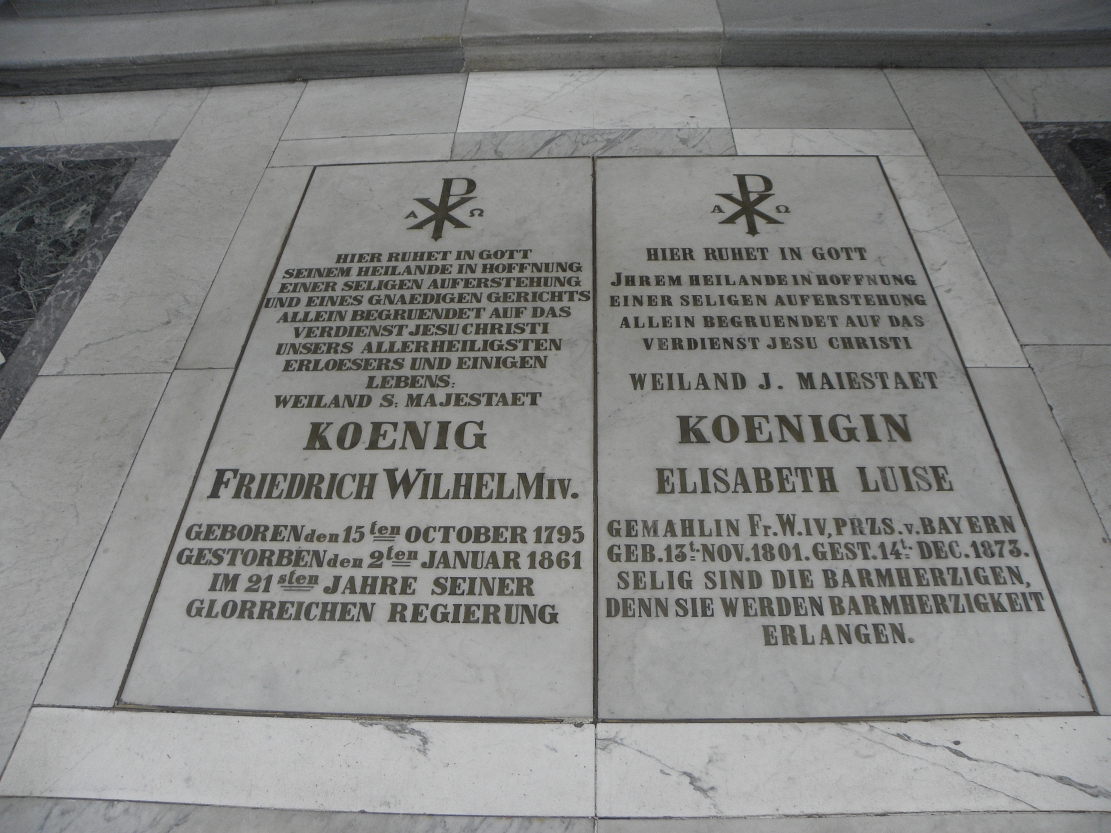
The entrance to the royal crypt; By Ra Boe / Wikipedia, CC BY-SA 3.0 de, https://commons.wikimedia.org/w/index.php?curid=11867337
The entrance to the royal crypt is under two marble tablets honoring Friedrich Wilhelm IV and his wife Elisabeth Luise in front of the altar steps. Friedrich Wilhelm IV died on January 2, 1861, following several strokes. His coffin rested in the sacristy of the Friedenskirche until it was moved to the royal crypt after its dedication in October 1864.
It was common to hold confirmations of members of the House of Hohenzollern at the Friedenskirche. Among those confirmed there were Wilhelm II, German Emperor, King of Prussia, son of Friedrich III, and his seven children.
Prince Georg Friedrich of Prussia, the great-great-grandson of Wilhelm II and the current head of the Prussian branch of the House of Hohenzollern, and Princess Sophie of Isenburg were married at the Friedenskirche on August 27, 2011.
********************
The Kaiser Friedrich Mausoleum
The Kaiser Friedrich Mausoleum; Credit – By Barbas, CC BY-SA 3.0, https://commons.wikimedia.org/w/index.php?curid=17290128
Friedrich III, German Emperor, King of Prussia reigned for only 99 days, dying at the age of 56 on June 15, 1888. Already seriously ill with cancer of the larynx, he succeeded his father Wilhelm I, German Emperor, King of Prussia on March 9, 1888. Friedrich III was succeeded by his son Wilhelm II, the last German Emperor and King of Prussia. The year 1888 is called “The Year of Three Emperors” in German history. Friedrich III’s coffin was initially placed in the sacristy of the Friedenskirche. From 1888 – 1890, the Kaiser Friedrich Mausoleum was added to the north side of the Friedenskirche. It was designed by architect Julius Carl Raschdorff who also designed the 1893 – 1905 reconstruction of the Berlin Cathedral. After the inauguration of the Kaiser Friedrich Mausoleum on October 18, 1890, the coffins of Friedrich III, along with those of his two sons who had died in childhood, were moved from the sacristy of the Friedenskirche to the mausoleum. When Friedrich III’s wife Victoria died in 1901, she was also interred in the mausoleum.
Julius Carl Raschdorff designed the mausoleum in the Baroque-influenced Italian High Renaissance style based upon the 17th-century Chapel of the Holy Sepulcher in San Candido, Italy which was modeled after the Church of the Holy Sepulcher in Jerusalem. The mausoleum is a domed building with a circular floor plan with an attached rectangular chancel. A gold mosaic on the vaulted ceiling alternately depicts angels and palm trees.

Tomb of Friedrich III, German Emperor, King of Prussia; Credit – Wikipedia
In the middle of the rotunda are the marble sarcophagi of Friedrich III, German Emperor and King of Prussia and his wife, the eldest daughter of Queen Victoria of the United Kingdom, Victoria, Princess Royal.
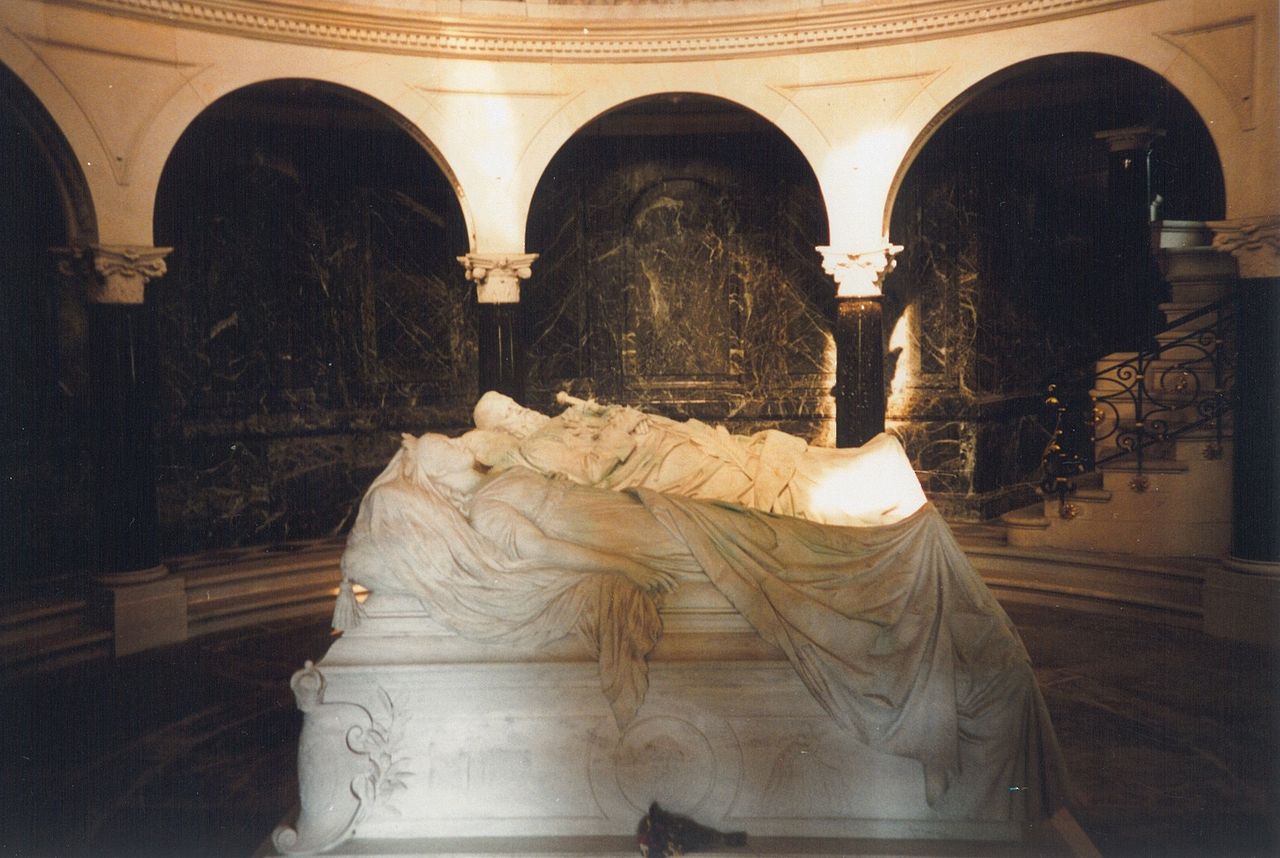
Tombs of Victoria and Friedrich next to each other; Credit – By TeeBee – Own work, CC BY-SA 3.0, https://commons.wikimedia.org/w/index.php?curid=47840199

Tomb of Prince Sigismund; Credit – Wikipedia
Prussian sculptor Reinhold Begas created the effigies of Friederich III and his wife Victoria and also created the tombs of Prince Sigismund and Prince Waldemar, the two sons of Friedrich III and Victoria who died in childhood, that stand against the side walls.

Tomb of Prince Waldemar; Credit – http://www.findagrave.com
Friedrich Wilhelm I, King of Prussia was originally interred at the Garrison Church in Potsdam, Kingdom of Prussia. During World War II, his coffin, along with several others, were moved, for their protection, to a salt mine near Bernterode, Germany. The coffins were discovered by occupying American forces, who re-interred them in St. Elisabeth’s Church in Marburg, Germany in 1946. Friedrich Wilhelm I’s original black marble sarcophagus was destroyed in 1945 and his remains were placed in a copy made from copper. In 1953, Friedrich Wilhelm I’s coffin was moved to Hohenzollern Castle in Hechingen, Baden-Württemberg, Germany. The coffin finally found its final resting place in 1991, on the steps of the altar in the Kaiser Friedrich Mausoleum in the Friedenskirche.
********************
Burials at the Friedenskirche

Sarcophagi of Friedrich Wilhelm IV and his wife Elisabeth Luise in the royal crypt; Credit – By Wo st 01 / Wikimedia Commons, CC BY-SA 3.0 de, https://commons.wikimedia.org/w/index.php?curid=7032743
- Friedrich Wilhelm I, King of Prussia (1688 – 1740) – in the Kaiser Friedrich Mausoleum
- Friedrich Wilhelm IV, King of Prussia (1795 – 1861) – in the royal crypt
- Elizabeth Luise of Bavaria, Queen of Prussia (1801 – 1873), wife of Friedrich Wilhelm IV – in the royal crypt
- Friedrich III, German Emperor, King of Prussia – in the Kaiser Friedrich Mausoleum
- Victoria, Princess Royal, German Empress, Queen of Prussia, wife of Friedrich III – in the Kaiser Friedrich Mausoleum
- Prince Sigismund of Prussia (1864 – 1866), son of Friedrich III, died from meningitis at 21 months – in the Kaiser Friedrich Mausoleum
- Prince Waldemar (1868 – 1879), died from diphtheria at age 11, four months previously, his mother’s sister Alice, Grand Duchess of Hesse and by Rhine and Alice’s youngest child May had died of the same disease – in the Kaiser Friedrich Mausoleum
********************
The Temple of Antiquities
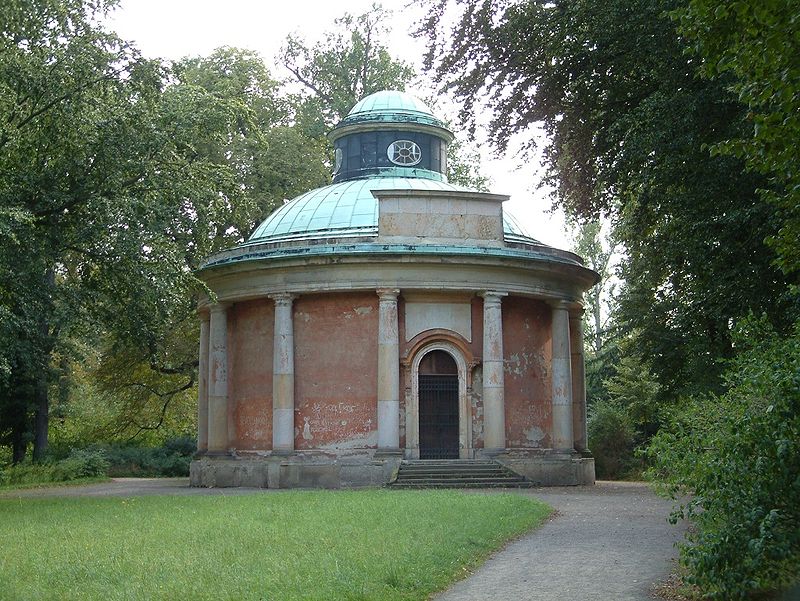
The Temple of Antiquities; Credit – Wikipedia
While it is now a mausoleum, the Temple of Antiquities was originally built to house the collection of classical works of art, antique artifacts, antique coins, and antique gems of Friedrich II (the Great), King of Prussia. Wilhelm II, German Emperor, King of Prussia intended to convert the Temple of Antiquities into a court chapel but the plans were never carried out because of World War I. On April 19, 1921, Wilhelm II’s first wife Augusta Viktoria of Schleswig-Holstein, German Empress, Queen of Prussia was interred in the Temple of Antiquities as per her wishes and it became the burial site of several other members of the House of Hohenzollern.
All the Hohenzollerns interred at the Temple of Antiquities are relatives of Wilhelm II, the last German Emperor and King of Prussia. After World War I, Wilhelm II went into exile in the Netherlands, where he purchased Huis Doorn, a small manor house outside of Doorn, a small town near Utrecht in the Netherlands. As a condition of his exile, Wilhelm could never return to Germany and was allowed only to travel within a radius of fifteen miles from his house. A mausoleum in the garden of Huis Doorn near Wilhelm’s favorite rhododendrons was built to house his remains. Both his wives were interred at the Temple of Antiquities.

Coffins inside the Antique Temple; Credit – Wikipedia
Those interred at the Temple of Antiquities:
- Augusta Viktoria of Schleswig-Holstein, German Empress, Queen of Prussia (1858 – 1921), 1st wife of Wilhelm II, the last German Emperor, King of Prussia
- Prince Joachim of Prussia (1890 – 1920), son of Wilhelm II, German Emperor, King of Prussia, died by suicide, originally interred in the Friedenskirche, transferred to the Temple of Antiquities in 1931
- Prince Wilhelm of Prussia (1906 – 1940), son of Crown Prince Wilhelm and grandson of Wilhelm II, German Emperor, King of Prussia, killed in action during World War II
- Prince Eitel Friederich of Prussia (1883 – 1942), son of Wilhelm II, German Emperor, King of Prussia
- Hermine Reuss of Greiz, German Empress, Queen of Prussia (titles held in pretense) (1887 – 1947), 2nd wife of Wilhelm II, the last German Emperor, King of Prussia
This article is the intellectual property of Unofficial Royalty and is NOT TO BE COPIED, EDITED, OR POSTED IN ANY FORM ON ANOTHER WEBSITE under any circumstances. It is permissible to use a link that directs to Unofficial Royalty.
Works Cited
- De.wikipedia.org. 2022. Antikentempel – Wikipedia. [online] Available at: <https://de.wikipedia.org/wiki/Antikentempel> [Accessed 11 March 2022].
- De.wikipedia.org. 2022. Friedenskirche (Potsdam) – Wikipedia. [online] Available at: <https://de.wikipedia.org/wiki/Friedenskirche_(Potsdam)> [Accessed 11 March 2022].
- En.wikipedia.org. 2022. Antique Temple – Wikipedia. [online] Available at: <https://en.wikipedia.org/wiki/Antique_Temple> [Accessed 11 March 2022].
- En.wikipedia.org. 2022. Church of Peace, Potsdam – Wikipedia. [online] Available at: <https://en.wikipedia.org/wiki/Church_of_Peace,_Potsdam> [Accessed 11 March 2022].
- Royaltombs.dk. 2022. The Valley of the Kings – Burial Places of European Monarchs. [online] Available at: <http://www.royaltombs.dk/> [Accessed 11 March 2022].
- Unofficial Royalty. 2022. Kingdom of Prussia Index. [online] Available at: <https://www.unofficialroyalty.com/current-monarchies-article-index/german-royals-index/prussian-index/> [Accessed 11 March 2022].
